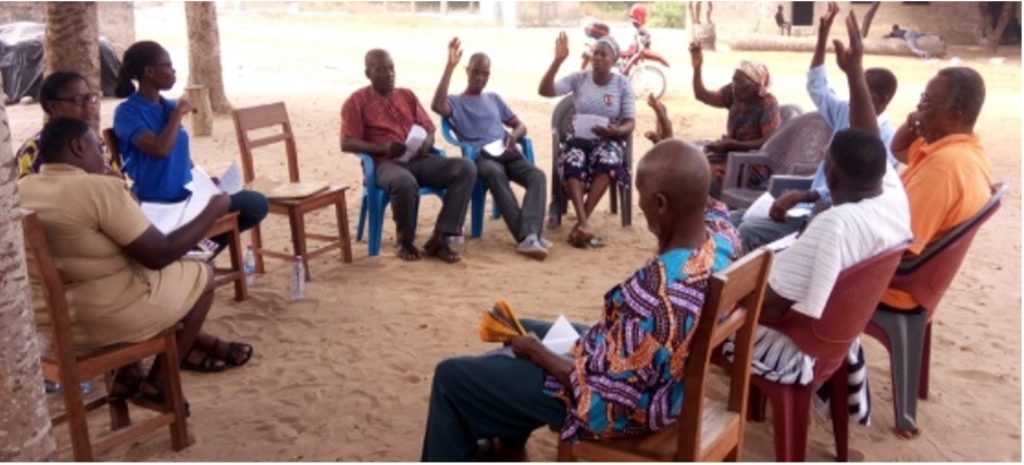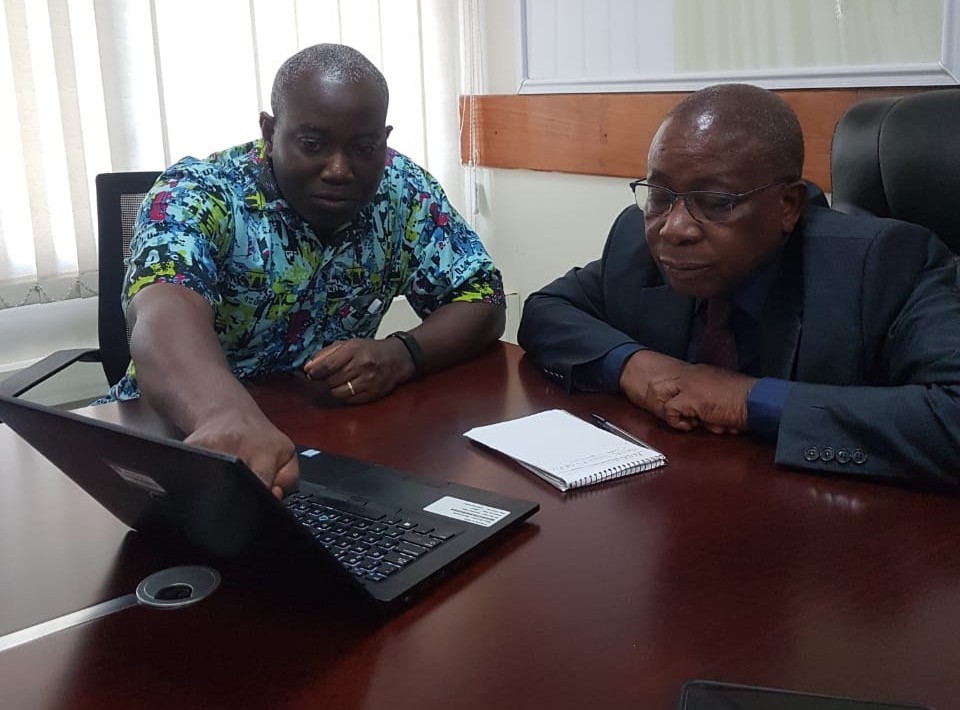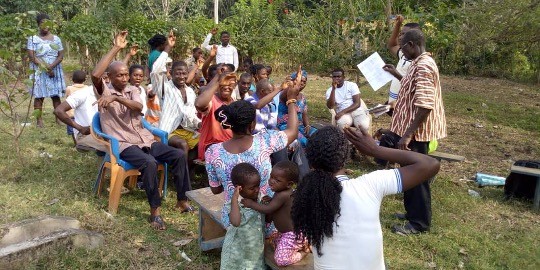Introduction
In less than 2 years, the Ministry of Health (MoH) of Ghana and the Ghana Health Service (GHS) with technical support from the African Leaders Malaria Alliance (ALMA) and other partners – initiated a high-impact programme aimed at strengthening health system accountability and driving action with the goal of enhancing utilization of basic primary health care services in the country. Known as the Community Scorecard (CSC), this initiative regularly engages communities to identify system gaps and provides an opportunity to close gaps in communication and collaboration between consumers (demand side) and service providers (supply side). The CSC offers a systematic way to gather, act, monitor and evaluate proposed actions that addresses service delivery challenges. This is done through a quarterly assessment and scoring process of nine (9) primary quality of care indicators led by Community Health Management Committees (CHMCs).
Beginning in January 2018, the CSC was developed to enhance the health sector’s ability to gather community feedback on a quarterly basis on the delivery of health services. From the start, the CSC tool was integrated into Ghana’s Community-based Health Planning and Services (CHPS) program, a national strategy aimed at delivering essential primary health care services with active involvement of communities. With extensive partner participation and media coverage during its development, the CSC is already receiving high visibility and recognition in the country.
As of December 2019, impressive progress had been made with 12 regions out of the total 16 in the country participating in the CSC roll-out. Out of all 6,000 CHPS zones across Ghana, over 1500 zones (25%) have been trained on the CSC. This involved considerable partner support, particularly from WHO, USAID Systems for Health Project, the World Bank, the Doris Duke Charitable Foundation (DDCF) and ALMA. Most of the trained CHPS zones are also reporting data into the national DHIMS2 and a scorecard web platform that has the capacity to not only show real-time scoring data but also actions taken in response to quarterly action plans.

Ghana community scorecard indicators
- Caring, respectful and compassionate care
- Waiting time for provision of health care services
- Availability of medicines, diagnostic services and medical supplies
- Availability, accessibility and quality of health care service and infrastructure
- Leadership and management of facilities
- Cleanliness and safety of facility
- Home visits by CHO/CHN
- Home visits by CHW/CHV
- Assessment of NHIS services
Step by step process
Step 1: Garnering political and partner support
In March 2016, the President of Ghana launched the revised National CHPS Policy to help accelerate new approaches to CHPS implementation by ensuring community participation, empowerment and ownership of the local health system, determining package of CHPS services at any CHPS zone based on inputs from the community, and considering communities as social and human capital for quality health care delivery.
Shortly after this policy update, ALMA organized a study tour to Ethiopia for a technical team from the Ghana MoH to learn about Ethiopia’s Community Scorecard experience. The Ethiopia community scorecard provides a systematic yet simple way for communities to routinely track the quality of care provided within their localities as well as a mechanism to aid communities and MoH officers in managing action plans developed with community input.
Ghana’s MoH Technical Team, with support from ALMA, presented findings from the Ethiopia Study Tour to both the Minister of Health and the Director General (DG) of the Ghana Health Service (GHS).
With the support of ALMA, Ghana had introduced in 2014 the Reproductive, Maternal, Newborn, Child and Adolescent Health Scorecard and in 2017, ALMA assisted the Ghana Ministry of Health with the development of a second scorecard focused on malaria control and elimination, which has proved critical tools to improve performance and enhance service delivery. The Minister fully endorsed the recommendation to fast track the introduction of a Community Scorecard in Ghana and recommended the addition of an indicator related to the performance of the National Health Insurance Scheme (NHIS) at the CHPS level. The DG also became an outspoken public advocate of the CSC; met with his senior management team to clarify roles related to the CSC roll-out; and sent a circular mandating all Directors of the Regional Health Directorates to ensure CSC implementation within their respective regions. MoH and GHS executive managers also requested access rights to the scorecard web platform once operational so that they could personally review community scores and aggregated information at all levels of the health system.
In addition, a number of key partners working to improve primary health services, support universal health coverage, improve CHPS functionality and/or enhance quality of care were made aware of the MoH/GHS’ plans to incorporate the CSC into CHPS implementation. Those who became actively involved with the CSC roll-out include USAID’s Systems for Health (S4H) Project implemented by University Research Co. (URC), JHPIEGO, PATH among others; UNICEF; UNFPA; WHO’s Quality Improvement (QI) Network; the Institute for Healthcare Improvement’s UBORA Project; the World Bank’s Maternal, Child Health and Nutrition Project; and the National Programme for Strengthening the Implementation of CHPS Initiative in Ghana (CHPS+).
The (GHS) Director General has always advocated for the Community Scorecard. Just last week at the senior management meeting, he encouraged all regions to get the perspectives of the community on the services we provide. He emphasized that the main aim was to improve the services. So, the DG is very keen and he is well-versed in talking about the scorecard and what it has come to do.
National CHPS Coordinator, GHS, Accra

Step 2: Agreement on the indicators
The Ghana MoH Technical Team that had travelled to Ethiopia to observe how the CSC was being implemented there felt that the best approach to CSC indicator selection in Ghana would be to adapt Ethiopia’s 6 indicators to fit the Ghanaian context and to add 2 additional indicators. These 8 indicators were found to not only be relevant, but also to be defined with enough clarity for communities to score consistently; and were therefore put forward for management approval. Interestingly, as mentioned above, the Minister of Health had taken such interest in this process that he requested a 9th indicator be added focused on obtaining community feedback on how well the NHIS program was being implemented within primary health care facilities.
Step 3: Integration into existing structures
The CSC was integrated into existing CHPS structures and forum to significantly strengthen implementation of the CHPS strategy in order to empower communities to actively monitor and provide feedback to health authorities on the quality of services, and create a platform for government and key stakeholders to jointly address gaps identified by the users of primary health care services.
In addition, it was agreed that existing Community Health Management Committees (CHMCs) use the tool during their regular quarterly meetings as per CHPS policy guidelines, along with integrated CHPS and CSC-related action planning and tracking processes. As per CHPS policy, local leaders from each CHPS zone with diverse competencies and constituencies are encouraged to volunteer to serve on a Community Health Management Committee (CHMC). Each CHMC is expected to meet quarterly to guide management of the CHPS zone in their community. They are also requested to invite other key community members, who are not part of their committee, to join them and develop Community Health Action Plans (CHAPs) for implementation in the CHPS zone.
Prior to introduction of the CSC, Community Committees did not have a clear, quantifiable approach for assessing the performance of their local health service delivery point. Therefore, the first step in using the CSC at the CHPS zonal-level is to support the CHMC, in cooperation with CHPS Zonal staff, on how to take the lead in utilizing the tool and associated action planning processes. This is done through training on how to score, vote and develop action plans using the 9 pre-defined quality of care indicators. Following introduction of the CSC management and social accountability tool into the quarterly meetings of the CHMCs, it was also noted that their work became more ‘efficient, robust and effective and that Action Plans are now also increasingly being implemented since they are directly linked to the participatory, community-led assessment and scoring process completed using the CSC.
Step 4: Selection of regions/CHPS zones
Roll-out within the regions began in November 2018. This first required selection of the regions, districts, and CHPS zones to be included in the program.
The GHS established the following three primary selection criteria:
- Regions with a high number of CHPS zones with low coverage for essential maternal and child health interventions
- Regions with CHPS zones included in the Quality Equity Dignity Network (QEDN). This is because the approach taken by this WHO multi-country initiative well matches the purpose and indicators of the CSC; namely improving quality of health services through improved engagement with communities; effective communication between providers and clients; and motivated health professionals who provide care that takes into account the preferences and aspirations of individual service users.
- CHPS zones with existing Community Health Management Committees (CHMCs) in line with the CHPS policy implementation structure.
Utilizing the above criteria, eight regions were initially selected. Partner support, beyond that from WHO’s QEDN, soon became another deciding factor in the selection of zones for start-up of the program. This was because partners played a major role in financing and providing technical oversight for the training required at multiple levels, with the USAID-funded S4H Project first supporting training in 5 regions and focusing on those CHPS zones not functioning well despite having CHMCs in place. Soon this approach became part of the criteria used by most areas included in Phase 1. The final set of geographic areas reached in Phase 1 included 97 districts (37% out of a total of 260 districts in 12 of 16 regions) are those indicated in the table below, along with the primary funding partners.
| Region | Total districts | No. of districts with CSC | District coverage % | Primary funding partners |
|---|---|---|---|---|
| Ahafo | 6 | 0 | 0% | – |
| Ashanti | 43 | 5 | 12% | WHO-QC |
| Bono | 12 | 0 | 0% | – |
| Bono East | 11 | 0 | 0% | – |
| Central | 22 | 22 | 100% | USAID |
| Eastern | 33 | 5 | 15% | ALMA |
| Greater Accra | 29 | 8 | 28% | USAID, UBORA/IHI |
| North East | 6 | 5 | 83% | USAID |
| Northern | 16 | 12 | 75% | USAID, World Bank, DDCF |
| Oti | 8 | 7 | 88% | DDCF |
| Savannah | 7 | 7 | 100% | DDCF |
| Upper East | 15 | 5 | 33% | ALMA |
| Upper West | 11 | 0 | 0% | – |
| Volta | 18 | 13 | 72% | USAID, World Bank, DDCF |
| Western | 14 | 2 | 14% | USAID, WHO-QC |
| Western North | 9 | 6 | 67% | USAID |
| Total | 260 | 97 | 37% |
Step 5: DHIMS2 configuration and interoperability with the Scorecard Web Platform
Working closely with the GHS Center for Health Information Management, and with technical support from ALMA, the MoH worked to integrate the community scores of CSC indicators to DHIMS2. In addition, the community scorecard is also integrated to the Scorecard Webplatform. The Scorecard webplatform tool is an online based management tool developed by ALMA and used by 40+ countries, which offers several management functionalities for follow-up of actions and workplans. Action Plans, known as Community Health Action Plans (CHAPs) in Ghana, are also uploaded and tracked on the scorecard web platform for greater accountability.
Step 6: National orientation, cascading and training of trainers
Start-up began with a national orientation involving the heads of national MoH programs. The Minister of Health and Permanent Secretary along with the Head of Program Planning Monitoring and Evaluation (PPME) and MoH officers who had participated in a study tour to learn about Ethiopia’s CSC process, facilitated the orientation. After agreement on the process and CSC indicators, a national MoH CSC Focal Point was named and the national-level trainers were identified to participate in a national level Training of Trainers (TOT). Regional level TOTs were then organized, with key stakeholders also involved. Those trained at the regional level, generally by national MoH trainers and the Regional Community-based Health Planning and Services (CHPS) Coordinator, are responsible for ensuring the CSC tool is taken down to the community level. This is done through cascading training of district/metropolitan and sub-district/municipal TOTs and the provision of support supervision and oversight of the roll-out process by the Regional Teams. They ensure those trained at all decentralized levels are knowledgeable of the policy and understand how the CSC supports its implementation. CHPS Coordinators at each decentralized level are also designated and play an important role in developing the training schedules and keeping momentum going for the roll-out.

Summary
A majority of those interviewed have indicated that the communities who have been trained and started to use the CSC are happy with the scorecard and the process. This is evident by the extent to which CHMCs and other community leaders are actively participating in the quarterly scoring and action planning meetings. Many are also successfully mobilizing resources, including making donations themselves, to ensure planned actions are implemented (please refer to ‘Ghana CSC Case Study #3 – Achievements’ for more details). In addition, there is strong support by high-profile officials from the MoH and the GHS. The task ahead is to make the CSC known more to the public at large, as well as to more CHMCs and partners who were not involved in Phase 1 of the Roll-Out.
Training best practices
Though training approaches have evolved and varied across regions and time, lessons learned from implementation have led the GHS to agree on standardizing the following approach to maximize the probability of a successful rollout:
Part 1: Two day training during initial rollout
The first day is dedicated to training community members (CHMCs), health professionals and key regional and district staff on how to conduct a scoring session and develop action plans, and includes a simulation exercise to gauge participant comprehension. On the second day, participants go to their respective communities and conduct a real scoring session and develop action plans, with the support of national, regional, and district staff to guide them and provide further instruction if necessary. Most training have been done at district capitals with no more than 50 people (maximum of 5 communities are trained at a time, with at most 10 participants from each community.)
Part 2: Peer exchange visits
Recognizing the importance of exchanging knowledge on the CSC, including lessons learned and best practices, GHS plans to have each region periodically conduct knowledge sharing workshops by convening 5 of the best performing CHPS zones (in terms of CSC implementation) and 5 underperforming CHPS zones. During the workshops, the CHPS zones will discuss challenges, solutions and strategies for scaling-up best practices. At the end of the training, a digital login account is created for all trainees so they can view their scoring sheets, action plans and indicator trends on the web platform.
